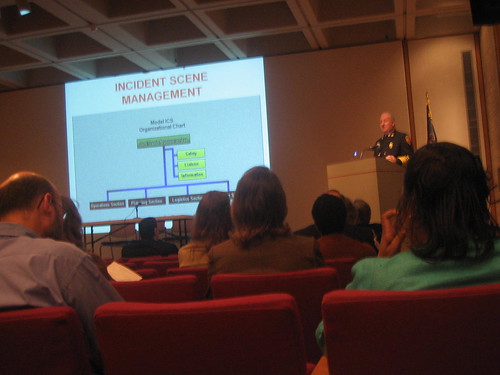This article is more than 5 years old.

This forum was organized by Heritage Preservation to organize community groups to respond to disasters. First responders and cultural preservation groups from federal, state and local entities joined in the forum. This was the first such forum in North Carolina and focused on responders in the Triangle area. It was good to see fellow Preservation Librarians Andy Hart(UNC-CH) and Winston Atkins(Duke) before the event. During the morning break, I met with Alix Bentrud, Preservation Services Librarian for Lyrasis. She and I had corresponded about developing the ZSR Continuity of Operations Plan. We discussed our plan and what ZSR is trying to accomplish. Alix is mulling over the idea of a Lyrasis class on this topic, so I passed a copy of our template along to her. This was a good contact and discussion. Each presenter had only 15 minutes- so it was quick and dirty disaster preparedness all day.
Robert James, Executive Director of the NC Preservation Consortium led off welcoming everyone and thanking Heritage Preservation for their sponsorship. Larry Wheeler, Director of the NC Museum of Art also welcomed the crowd and talked about the new NC Museum of Art building (opening in April, 2010).
David Brook, Director, Division of Historical Resources, presented on “Why Protect Cultural Heritage?” He gave an overview of our cultural resources-their value and the threats to them.
Dr. Marty Matthews, Curator of Research, NC Historic Resources presented on “Triangle Cultural and Historical Treasures.” This was a quick summary of cultural resources in libraries, archives, museums, monuments, and State Historic sites in the Triangle.
Jane Long, VP of Emergency Programs, Heritage Preservation presented on ‘Risks and Response: How Emergency Systems Work.” The Alliance for Response initiative was formed to bring together cultural and emergency professionals before disasters occur. These meetings have been held in 9 cities since 2003. It consists of educational programs and training, and networks and policies are developed- (listservs, alert systems and contact systems).
Joshua Creighton, Dir. Wake Co. Emergency Mgt. and John McGrath, Chief Raleigh Fire Dept. presented on “How Emergency Systems Work.” Creighton spoke on threats- natural, technological and man-made; how you must evaluate your threats, and reduce risks to threats and overcome vulnerability. He said we must work with local responders. Chief McGrath spoke about the incident command system during a response to an emergency. He made the same point Creighton did: You have a place at the table during the emergency by interacting with the liaison officer. You should identify yourself to the scene commander, account for all personnel and mechanical operations. After the emergency, those with subject matter expertise must help establish salvage priorities. The Fire Dept. actually provides equipment-including breathing apparatus to allow trained staff into the structure for recovery.
April Cummings, Environmental Historic Team lead-FEMA presented on the federal response to a disaster. FEMA provides individual and public assistance and hazard mitigation after a disaster is declared. Assistance, insurance, disaster, housing assistance, and small business loans are provided. The National Historic Preservation Act takes into account the effects of their undertakings on historic properties. FEMA funding for historic sites- reviews the scope of the work, and determines eligibility prior to work beginning. Have a disaster place in place to minimize damage and coordinate response.
Martha Battle Jackson, Curator, NC Historic Sites, presented on” Disaster Team Roles.” She reviewed the ideas of Preparedness(ready at all times, prepare in advance, stockpiling equipment, practicing); Response (fac. Mgt, communication, security, data collection-photographing the recovery process, logging the images, etc. ) and Salvage (review functions, sorting, recording, packing, develop a tracking system).
Bill Gentry, Program Director, Community Preparedness and Disaster Management School of Public Health, UNC-CH presented on “Health and Safety following a Disaster.” He urged us to follow safety personnel after a disaster-do not assume the building is safe, use common sense. Hazards can be electrical, structural, mold, hydration for workers, air pollution/residue, mental health concerns and stress.
Elaine Wathen, Asst. Director, Information and Planning, NC Emergency Management presented on preparedness training. The NCEM provides training: exercises, elaborate discussions, or full scale role playing in a scenario.
Sarah Koonts, Head of Collection Management, NC State Archives presented on bringing people together to protect our vital records and archival treasures. Preparation before a disaster is key and helps during an actual disaster. Council of State Archivists took the lead role in planning how to protect vital records after Katrina and developed new methods and procedures. IPER-developed after Katrina, is web based training and support.
Darryl Aspey, NC Protective Security Agent, Department of Homeland Security presented on strengthening the infrastructure of the state against threats. Homeland Security has developed the National Infrastructure Protection Plan to detect threats, mitigate outcomes and recover. Their plans include protection plans for water, dams, monuments, state and federal facilities, etc. Protective Community Advisors advise local communities.
Carolyn Freitag, Emergency Management Assistance CompaCoordinator (EMAC) presented on mutual aid agreements in NC. All 100 counties have signed agreements supporting aid and assistance among local governments. EMAC is a national agreement developed after Hurricane Andrew. It facilitates efficient sharing of resources between member states during times of disaster or emergency. This is done with response teams.
David Goist, a professional conservator presented on model networks for cooperation and response. He introduced AIC Collections Emergency Response Team (CERT). This group advises on disasters.
Frank Thomson, Curator, Asheville Museum of Art and Andy Hart, Preservation Librarian, UNC-CH, discussed their networks: MACREN(Mountain Area Cultural Resources Emergency Network) and the Triangle Research Libraries Network Disaster Team. These networks respond to emergencies in their areas to recover cultural materials.
It was a day that covered so much, it was hard to absorb it all. The concept of a response team is a great one and I hope the Triangle area is successful in establishing a team.

1 Comment on ‘Triangle Alliance for Response Forum, NC Museum of Art, Raleigh’
Glad you were there, Craig!